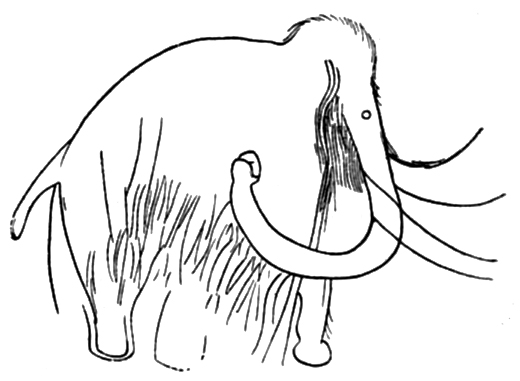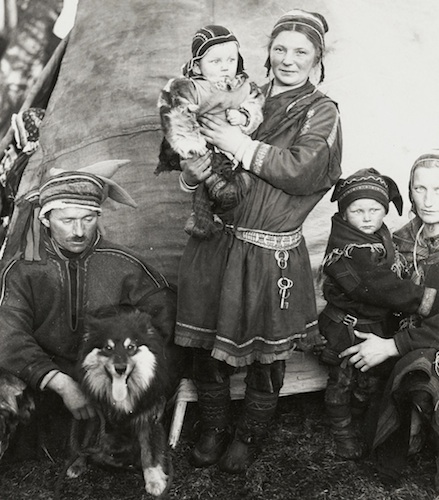DNA
Analysis and proofs
I1-M253, I1-DF29+CTS6364+CTS10028+
I1-L22+FGC41265+Y21091+Y24789+A14470+FT192265+
according to the I1 yDNA Haplogroup
Family Tree DNA analysis by Elroy
Christenson
Some of the first contacts with DNA matches were with people who had done very little in historical research and were hoping for a quick information on their own families without offering anything in return. Sometimes they had only researched their own immediate families. A few have had an adoption in their background which presented a major dead end. This is not unlike traditional genealogy research. I share my research freely rather than putting it on a commercial genealogy site. However, much of my work has ended up on these site because others have used that for their own families. I have no real problem with that because much of what I have used has been developed by other researchers with whom I have corresponded and conferred. I only ask that my web pages be given credit as the source. I would also request that DNA researchers at least identify who they are and give some background of their ancestors.
We know that Homo Sapiens first settled in Europe between 40,000 and 35,000 YBP("Years Before Present") probably during a particularly warm spell but forced back out after the glaciers returned between 20,000 - 16,000 YBP. [Carpelan]. The I1 group is said to have been the first group of people to arrive in northern Scandinavia. My DNA was first analyzed to the particular haplogroup of I1-M253. The I1-M253 is one of the oldest lines in Europe going back, according to present theories, to 3,470 to 5,070 years. The originating line of I-M170 seems to come into Europe about 10,000 BCE or 15,000 BCE. The I-M253 springs from this with its mutation about 1000 to 2000 years before some of the other groups and actually may go back to only 8 male and female pairs and their offspring. This first group of settlers are known now by familytreeDNA as "Hunter-Gatherers". Initially they were identified by country names but that to me was very wrong since no countries existed at that time. There are still debates among DNA researchers as how this puzzle goes together. The "Hunter-Gatherers" first came into present day Europe about 45,000 years ago. Their population was overwhelmed by the migrations of the Neolithic Farmers who came out of the Fertile Crescent of present day Syria and Iraq eventually migrating through into present day Turkey and Greece by 6800bce and Spain by 5200bce. At 5500bce in a present-day Romanian river valley was one of first settlements of fishermen and farmers living side-by-side to establish the Indo-European people who settle western Europe. About 4000bce they also moved into the British Isles and Scandinavia. Remnants of their DNA is still visible in contemporary populations, according to the latest article in National Geographic magazine, 2019 by Andrew Curry. [Curry. Nat. Geo., Aug, 2019]
A new culture has been identified recently that comes in from the north. The Yamnaya culture that developed the use of the horse and cart seems to be centered in the Ukraine and southern Russia but also spreads into Asia and moves through the Balkins 3300bce into France by 2200bce perhaps because of their mobility. They may be the makers of "Corded Pottery" 2900bce that takes the dominate roll in population in Europe around 2200bce in the British Isles. There is a great mystery about the events that brought that about. According to Curry, since their roots are in the Near East they may have built up some immunity for a form of the very contagious Black Plague. If the originating settlers of Europe had no such immunity their culture could have easily have been wiped-out and supplanted by the Yamnaya. This is the R1b DNA that is still the 2nd most dominate population of Europe and the most dominate in Norway. They are the burial mound builders. [Curry. Nat. Geo., Aug, 2019] They may be the Tarim mummy people described below in Western China and Tibet.
One change of the DNA was a mutation that brought about I1-L22 about 4100bce and later I1-P109 was identified at about 3,000 to 4,000 years old. The present theory is that I-M253 was dispersed from Denmark and I-P109 in particular is associated with the southern Denmark Scandinavians. [wikipedia 2015] Whereas the L22+ "is the main Nordic subclade. It is also very common in Britain, especially on the east coast where the Vikings settled most heavily, in the Low Countries and Normandy (also doubtlessly the heritage of the Danish Viking), as well as in Poland and Russia (Swedish Vikings)." ["Haplogroup I1" europedia.com 2016] The I haplogroup was much more dominate in the ancient skeletal remains in Denmark (up to 13%) and was theoretically overwhelmed by new emigrate strains from other areas ("I" group now about 2.5%). It may have been the dominate "ancient Southern Scandinavian type." [Hofreiter] It is still more frequent in Finnish populations than any other country in Europe. Other groups, such as R1B1, frequently associated with the Germanic tribes, comes in later and through other migratory routes. The I1 haplogroup is the most common in northern Europe and is found in about 35% of the male population of Scandinavia and Finland. It was present in Mesolithic Hunter-Gatherers times along side G2a2b group from Western Hungary. Ken Nordtveldt's theories on DNA inheritance spreads back to humanoid beginnings and lays out an interesting history here used in the topic of "I1" on familytreedna.com. [Nordtveldt 2010] It has spread to other regions through settlements and invasions and shows up in much small numbers in Germany, England, Scotland, Ireland, Russia and France. Some of the DNA spread in Britain through the Anglo-Saxon and Jute invasions after the fall of the Roman empire. In reality the Saxons came from the southern end of the Jutland peninsula, Germany and Holland whereas the Jutes came from the northern end and Angles from the middle. These tribes have often been broadly called Germanic but were a true mixture obviously containing a good deal of Scandinavian DNA. See the map on haplogroup I1 at the this web site which also has much other information. ["I1 DNA" Eupedia.com]
David Widerberg Howden of the Norway group laid out the time sequence for the different haplogroups. [Howden 10/13/2016]
- DF29: Is dated around 4700 Time to most recent ancestor.
- CTS6364: Is dated around 4200 Time to most recent ancestor.
- L22: Is dated around 4100 Time to most recent ancestor.
- P109: Is dated around 3400 Time to most recent ancestor.
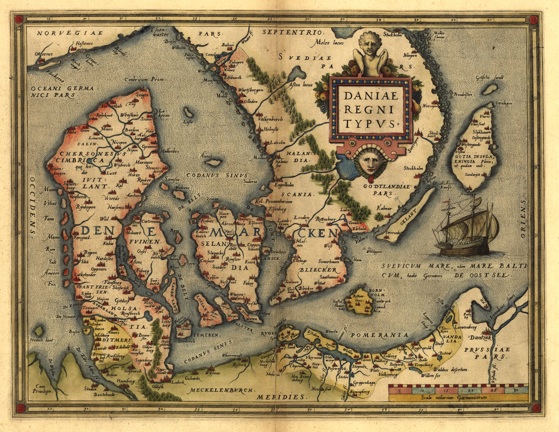 Denmark in 1500 digital copy owned by Elroy Christenson |
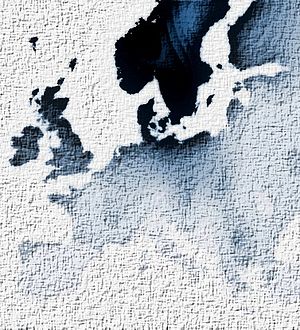 This map shows the dominate regions for I1-M253. [http://www.eupedia.com/europe/Haplogroup_I1_Y-DNA.shtml] |
The analysis of DNA is continuing to develop a more accurate picture of the origination of human migration. My own DNA was first analyzed as I1-M253 DNA and now confirmed I1-L22 is also, according to the familyfinder/myOrigins autosomal analysis is 50% Hunter/Gatherer, 40% Farmer, 10% Metal Age Invader. This seems to be most easily explained by some connection to the early nomadic tribes across the ice sheets - very unexpected. My own analysis originally showed a surprising 1-2% connection to East Asia and Northern Siberia. This is has now been changed to the Eastern European connection in the Magyar, centered on the Danube river basin in Hungary/Romania, at 4%. Although my own ancestors may not come from the Tarim basin, just north of Tibet, this discovery adds historical weight to the present theory of migration. The I1- L22 group is also known as "ultra Norse" by Professor Ken Nordvedt, one of the early scientists of DNA. Some others have titled this as "Continental/Scandinavian". I suspect this is intended to show the extent of the spread of this early group into England, Ireland, Scotland, Germany and France. It gradually is overwhelmed by other more recent sub-clads such as P109.
We don't really have a firm date for the when humans moved north but the receding glaciers and known hunting of woolly mammoths gives many clues. The original hut shown here was in Mezhyrich, Ukraine about 15,000 years ago. It is based on the discoveries of some 70 such huts from mammoth bones and tusks in Siberia which had probably also been covered with hides.
"Significant climate and habitat changes across Europe, Eurasia and the Americas appear to have preceded the large-scale extinction of megafauna like the woolly mammoth about 15,000 to 11,000 years ago, according to research that has gleaned evidence of environmental conditions directly from old animal bones." [Wallace. Cosmos, 19 Apr 2017]The Tarim mummies of northwestern China were looted for centuries but 1st scientifically investigated in 1910 but dates back to about 2000 B.C.E to 300 B.C.E. These 4000 year old people are known today as the Xiaohe people. The excavations of 330 tombs is unprecedented in age, size and scope. Because this area is one of the driest areas of the world the mummies are very well preserved. The earliest discovered mummies frequently have red hair, Caucasian features, and tattoos. Later dated mummies are more Mongolian in origin. They were buried with flutes, weapons, woolens, the first known trousers, woven plaid clothing and boat shaped coffins. They were the first group that seems to have domesticated horses which made their nomadic journeys cover vast distances and buried their horses with them. DNA analysis so far seems to confirm a mix of DNA from Europe, the Eastern Mediterranean, India and China. Theories so far identify this Tarim river area as a cross-roads of traders that existed for several hundred, perhaps thousands of years. It is located presently in the high desert created by the Himalayan mountains of Tibet with the Tarim river fed now only by the few melting glaciers. It probably was a major waterhole along the Silk Road that had been followed by Marco Polo. The residents here had farmed grains and developed a cultural ceremony for burials. The inhabitants were finally forced out by the ever encroaching desert and changing climate. [ed. Time-Life1993] [Wong 2008]
"Mammoth House" as shown at the "Frozen Woolly Mammoth Yuka Exhibit" in Yokoyama, Japan in Summer 2013. This replica was made for the exhibit with real mammoth fossils (bones and tusks)."[Nadaro 2013 - wikepedia.common.com] The drawing is of an engraving from the cave of Les Combarelles, France in the Dordorgne river area about 12,000 BCE. Drawings done about 1902 by Louis Capitan and Henri Breuil. Having visited several of the caves in the area and I can testify as to how easy it was to overlook these engravings. [Les Combarelles]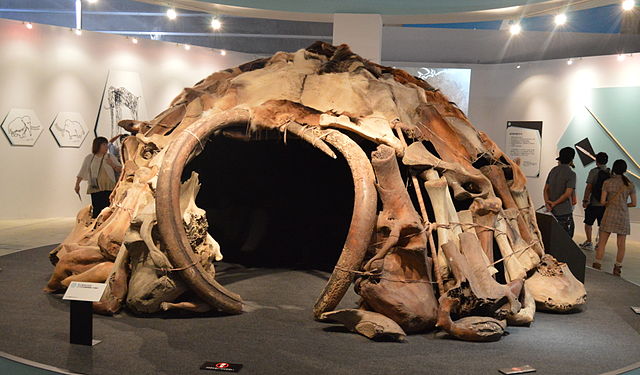
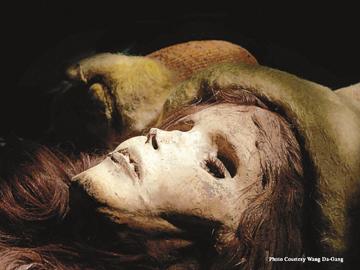
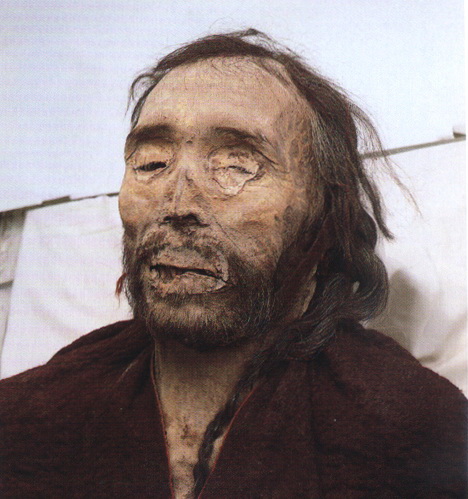
The Beauty of Xiaohe and the Tian Chen mummy.
The "Beauty of Xiaohe" seems to have died of lung problems at about the age of 40-45
caused largely by breathing in dust particles.
|
|
I also find it
interesting that the Saami/Sami people herded
reindeer across the tundra and lived a nomadic
lifestyle in much the same manner as the Inuit and
American Indians. According to some DNA
researchers there seems to be more of a DNA
relationship between the Inuit and the Basque people
than to the plains Indians or the French. It seems
from recent theories that the Saami would have had
to entered the Scandinavian peninsula after about
2000BCE which would make them late comers compared
with the I1 haplogroup.
[eupedia.com/Europe/Haplogroup_I1_Y-DNA.shtml]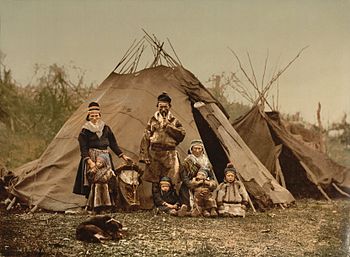 Saami herders of 1900 in northern
Norway.
[Wikipedia]
|
According to researchers, the I1 group were probably the hunter-gatherers more akin to the Samis and Finns than other groups that came in from the south bringing agriculture to Scandinavia. More recent research has found that it is one of the largest haplogroups among the Sami. The I1 group is further broken down into many subclad. My own I1-L22 is listed as Nordic. By the Viking Group I'm listed in the middle with IM253. By the Norman Group I'm filtered to be as middle example of I1-DF29+ CTS6364 CTS10028+ L22+ FGC41265+ Y21091+. Although I tested early for P109 it was proved negative. Presently L22 "is a very big Nordic branch. It is also very common in Britian, especially on the east coast where the Vikings settled most heavily, in the Low Countries and Normandy (also doubtlessly the heritage of the Danish Viking), as well as in Poland and Russia (Swedish Vikings)." [eupedia.com 2022] "The main Scandinavian subclad that shows up with the Danish Viking settlements in England, Scotland, Ireland, Normandy coast of France, and the Isle of Man among others. This particular variation was a several hundred year later version than the L22. Even still the L22, according to some researchers, shows up most dominated in the area of southern Jutland, Denmark. This was the origin of some of the settlers of northeastern England as well as Normandy, France where early Danish settlements were established. I seem to be related to half of Europe including people in the countries of Russia, the Baltics, Spain, and Turkey. It has now been confirmed from nine skeletons in eastern England that "present day English owe about a third of their ancestry to the Anglo-Saxons" and I would also add the Jutes, who came in at the same time about 5th century AD. [Schiffels, "Iron Age... genomes.."19 Jan 2016 / Rincon, BBC News 19 Jan 2016]
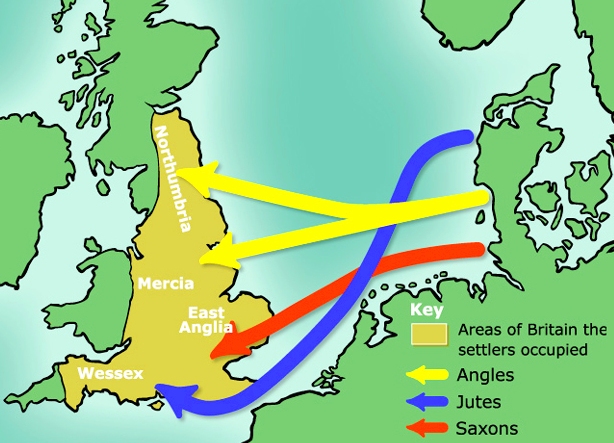 Settlement location of the Angles, Saxons and Jutes in England |
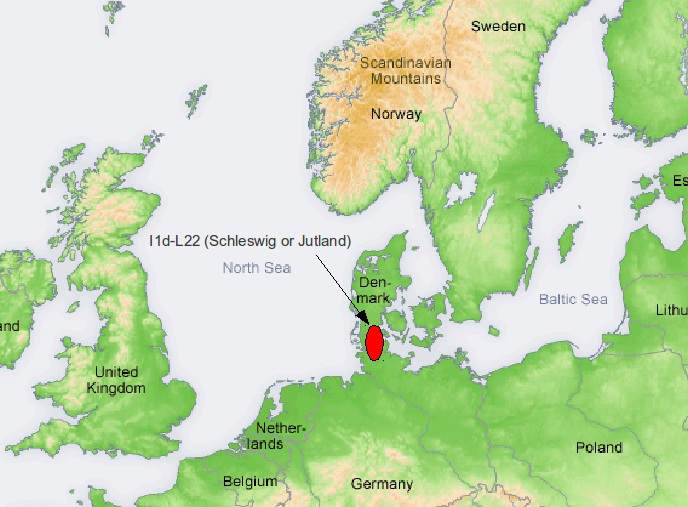 Family Tree DNA origin of I1d-L22 haplogroup. [familytreedna.com, 2016] |
| The Tollund Man shown here was found in
a bog in 1950 just north of the area on the map as
identified as I1d-L22 on the Jutland peninsula.
Michael Worffel-Intile of
the I1d-L22 group on facebook.com wanted me to
clarify that the Tollund man has not been proved to
be L22. "According to Eske Willerslev, DNA
researcher and professor at the University of
Copenhagen's Center for Geogenetics at the Statens
Naturhistoriske Museum, it has not been possible to
extract usable DNA from the Tollund man".
There are some fifty of these bog preserved bodies in
existence from areas around Europe are now in various
museums. This particular one is in the Silkeborg
Museum in Denmark, 25 miles south of Viborg or 35
miles north of Jelling. Although one of the best
preserves heads he is thought to have been hanged
before being thrown into the bog, perhaps as a form of
human sacrifice. The acids in the bog itself may have
degraded any possible samples. I find it interesting that this is the same area that many of my past relatives lived for at least five hundred years. If looks mean anything he resembles some of my present day relatives even though he is has been dead for about 2300 years. |
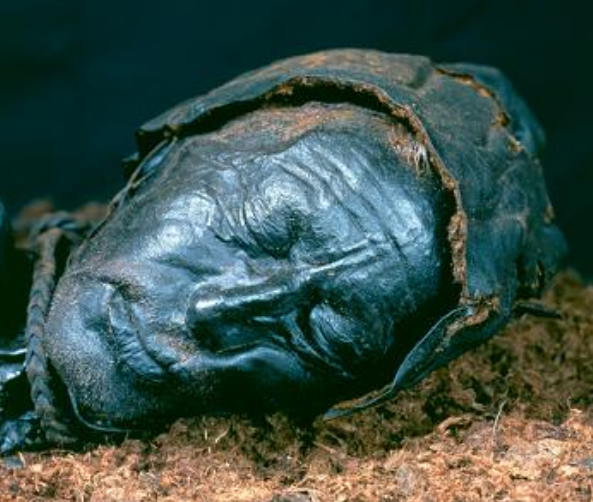 Tollund Man, Denmark, about 375 -
210bc
Silkeborg Museum, Denmark. (about 7.5 mi. west of the discovery site) |
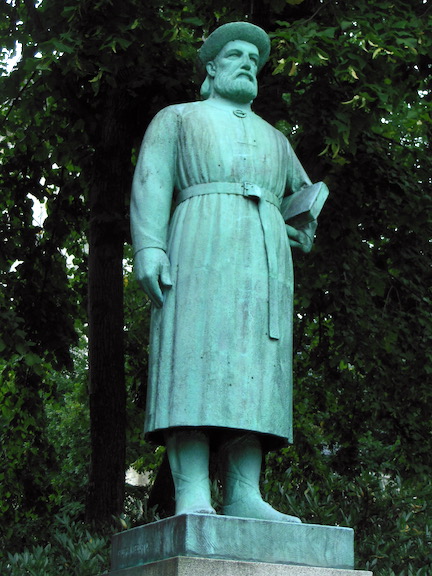
Snorri Sturluson in Trondheim, Norway
photo Elroy Christenson 2016
Quite naturally the oldest records are associated with nobility or wealthy families. I have now connected to royalty in my research which has pushed this research back beyond 900 CE. Often royal genealogies were invented to give credibility to their claim to the throne. Many early records can't be trusted and many modern researchers have appropriated family lines that they want, not that they can prove. The bulk of my families were farmers. They lived for several hundred years on the Jutland peninsula of Denmark and another group on farms for several hundred years in Hedmark and Oppland, Norway. They likewise were farmers when they came to the United States from Norway, Denmark, England, Ireland, and Scotland. At that time they may have been true believers in some protestant faith wanting to convert others to the faith or just trying to find a piece of land that they could plow into a livelihood for their families without having to pay a lord for the privilege.
